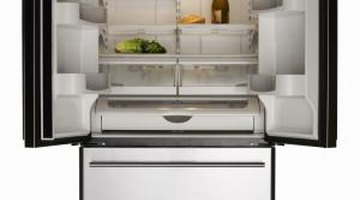My Unplugged Refrigerator Is Leaking
Refrigerators can have as many as three distinct sources of leaking water. The first is the ice maker, should your model be equipped with one. Second is the self-defrost mechanism on the freezer if your model is a refrigerator/freezer. Third is the condensation accumulated through the act of cooling relatively humid indoor air. Any one of these sources can continue to add water to your condensation pan, located in the bottom of the refrigerator, for some time after the unit has been unplugged.
Ice Maker

Check your ice maker to ensure it is not filled with ice that is melting. Ice is formed on a rack above the ice bucket or compartment. There may be some ice remaining in the ice rack that was never harvested in to the ice bucket. Remove the ice manually to prevent more leaking.
Self-Defrosting Freezer Compartment
If your refrigerator/freezer is equipped with a self-defrosting mechanism, the defrost drains may continue to drain water away from the freezer compartment for some time following the unit being shut off. Check the defrost drains and drain lines for signs of clogs that would lead to delayed draining. They are typically located in the back of the freezer compartment and can be accessed by removing the screen on the top of the drain.
Condensation
Refrigerators work in much the same way air conditioners do. Air taken from inside the refrigerator compartment is blown across a series of cold copper coils filled with refrigerant. This cools the air and also removes humidity from the air. The humidity condenses on the refrigerant coils and drains in to a condensation pan. This water can remain in the unit for some time and will have to be manually removed from the condensation pan to ensure there is no additional leakage.
Condensation Pan
All water removed from the freezer via the self-defrost mechanism or drained away from the compressor after condensing on the refrigerant coils winds up in the condensation pan. The condensation pan holds water, which evaporates in to the air, aided in part by its proximity to the hot compressor, condenser and fan motor. When the unit is unplugged, the electrical components do not speed up evaporation, and the pan may overflow. Remove the front grill on your refrigerator and slide the pan out from its seating. Dump the water and wipe down the pan before reinstalling.
References
Writer Bio
Andrew Leahey has been a writer since 1999, covering topics as varied as technology how-to guides and the politics of genetically modified organisms to African food supplies. He is pursuing his J.D. while renovating an 1887 farmhouse located in the New Jersey Pine Barrens.
Photo Credits
- Ryan McVay/Photodisc/Getty Images
More Articles
- How to Clean Your Haier Dehumidifier Filter
- What Are the Causes of Popping Noises in Chest Type Freezers?
- The Freezer Fan Is Not Working on My Side by Side Samsung Refrigerator & Freezer
- A Maytag Refrigerator Makes a Clicking Noise
- My Roper Refigerator Is Leaking Water From the Freezer to the Refrigerator
- Ice in Freezer of a New Refrigerator Tastes Bad



